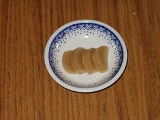
Takuan
Encyclopedia

Japanese people
The are an ethnic group originating in the Japanese archipelago and are the predominant ethnic group of Japan. Worldwide, approximately 130 million people are of Japanese descent; of these, approximately 127 million are residents of Japan. People of Japanese ancestry who live in other countries...
pickle
Pickle
Pickling is a process of preserving food. Pickle or pickling may refer to:-Food:* Pickled cucumber* Pickled onion* Pickled herring* Indian pickle includes oil-based food preservation* Branston and similar sweet pickle relishes...
. It is made from daikon
Daikon
Daikon , Raphanus sativus var. longipinnatus, also called White Radish, Japanese radish, Oriental radish, Chinese radish, lo bok and Mooli , is a mild flavoured, very large, white East Asian radish...
radish. In addition to being served alongside other types of tsukemono
Tsukemono
are Japanese pickles. They are served with rice as okazu with drinks as an otsumami , as an accompaniment to or garnish for meals, and as a course in the kaiseki portion of a Japanese tea ceremony....
in traditional Japanese cuisine
Japanese cuisine
Japanese cuisine has developed over the centuries as a result of many political and social changes throughout Japan. The cuisine eventually changed with the advent of the Medieval age which ushered in a shedding of elitism with the age of shogun rule...
, takuan is also enjoyed at the end of meals as it is thought to aid digestion
Digestion
Digestion is the mechanical and chemical breakdown of food into smaller components that are more easily absorbed into a blood stream, for instance. Digestion is a form of catabolism: a breakdown of large food molecules to smaller ones....
.
Takuan is made by first hanging a daikon radish in the sun for a few weeks until it becomes flexible. Next, the daikon is placed in a pickling crock and covered with a mix of salt
Edible salt
Salt, also known as table salt, or rock salt, is a mineral that is composed primarily of sodium chloride , a chemical compound belonging to the larger class of ionic salts. It is essential for animal life in small quantities, but is harmful to animals and plants in excess...
, rice bran
Bran
Bran is the hard outer layer of grain and consists of combined aleurone and pericarp. Along with germ, it is an integral part of whole grains, and is often produced as a by-product of milling in the production of refined grains. When bran is removed from grains, the grains lose a portion of their...
, optionally sugar
Sugar
Sugar is a class of edible crystalline carbohydrates, mainly sucrose, lactose, and fructose, characterized by a sweet flavor.Sucrose in its refined form primarily comes from sugar cane and sugar beet...
, daikon greens, kombu
Kombu
Kombu or konbu , also called dashima or haidai , is edible kelp from the family Laminariaceae widely eaten in East Asia....
, and perhaps chilli pepper and/or dried persimmon
Persimmon
A persimmon is the edible fruit of a number of species of trees in the genus Diospyros in the ebony wood family . The word Diospyros means "the fire of Zeus" in ancient Greek. As a tree, it is a perennial plant...
peels. A weight is then placed on top of the crock, and the daikon is allowed to pickle for several months. The finished takuan is usually yellow in colour, although most mass-produced takuan rely on food coloring for this effect.
Takuan Sōhō
Takuan Soho
was a major figure in the Rinzai school of Zen Buddhism.Takuan Sōhō was born into a family of farmers in the town of Izushi, located in what was at that time called Tajima province . At the age of 8 in 1581 young Takuan began his religious studies and 2 years later he entered a Buddhist monastery...
is creditied with concoting this yellow pickle, which now bears his name.
Takuan is also popular in Korea
Korea
Korea ) is an East Asian geographic region that is currently divided into two separate sovereign states — North Korea and South Korea. Located on the Korean Peninsula, Korea is bordered by the People's Republic of China to the northwest, Russia to the northeast, and is separated from Japan to the...
and is called danmuji (단무지). It is used as a filling for gimbap
Gimbap
Gimbap or kimbap is a popular Korean dish made from steamed white rice and various other ingredients, rolled in gim and served in bite-size slices...
, or as an accompaniment to Korean dishes, typically jajangmyeon
Jajangmyeon
Jajangmyeon is a popular Korean dish, derived from the Chinese dish zha jiang mian. It consists of wheat noodles topped with a thick sauce made of chunjang , diced meat and vegetables, and sometimes also seafood...
.

